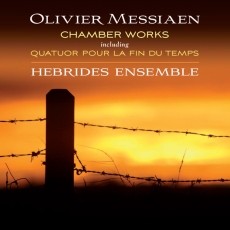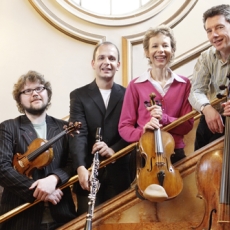Olivier Messiaen - Hebrides Ensemble - Music OMH
This collection of chamber works, played by the Hebrides Ensemble, shows Messiaen at his most engaging. All but one of the pieces on the album was written by the time he was 46 years old, by which stage he'd not become so individual that the listener is completely without reference. In the earlier pieces there are cadences and climaxes, in the old style, but always in Messiaen's forward-thinking way.
Famously composed while Messiaen was at a prisoner of war camp during World War II, using a piano whose keys didn't all work and a cello with only three strings, the Quartet for the End of Time is an undoubted masterpiece. Messiaen had a grasp in these days of tension and release (not surprising given the circumstances!), rewarding the listener with some of his most gorgeous music after stark, brutal passages. There are times when the music miraculously appears like glass and sugar, and the effect can be pretty dizzying. There is also the democracy of a little opera, in that each instrument gets its chance to shine either alone or in duets or trios, as well as a part of the whole ensemble.
There are many great and good recordings of this piece by well-known performers, but one thing that separates this version from all of those is that Philip Moore lets his piano produce an ugly sound whenever one is needed. Like a painter who might be unwilling to create a self-portrait showing any facial blemishes, pianists are usually too vain to let their instrument speak with a rough tone - but this piece contains rough music and Philip Moore is brave enough to let it out.
The Theme and Variations is an early masterpiece showing Messiaen's need to express something that searches as it moves. Faith, in a religious sense, is rarely about facts and being a devout Catholic was probably one of the bigger roots of Messiaen's constantly probing music. The fact that this piece was a wedding present to his first wife might also shed a little light on the blissful atmosphere of the music. For me the ultimate version remains the one by Martha Argerich and Gidon Kremer, but this isn't far behind.
The recently discovered Fantasie for piano and violin was written in 1933 (a year after the Theme and Variations) and is a very interesting find. It was published in 2007 and though it has all the great hallmarks of Messiaen's earlier style, like using bold single-line melodies and odd harmonies, there is a much stronger sense of linear motion and comfortable resolution than usual, which at times sounds a bit like Brahms' chamber music. How controversial! How conservative!
The album ends with another classic: Le Merle noir (Blackbird) It contains one of Messiaen's first fascinating depictions of actual birdsong and is written for unpredictable flute with piano accompaniment.
If you love the music on this CD then you might already own a couple of versions of these pieces, but for Moore's dark reading of the Quartet and for the clues as to Messiaen's early development in the newly found Fantasie, it's well worth coughing up for. The sound quality is as crisp and detailed as the performances.

